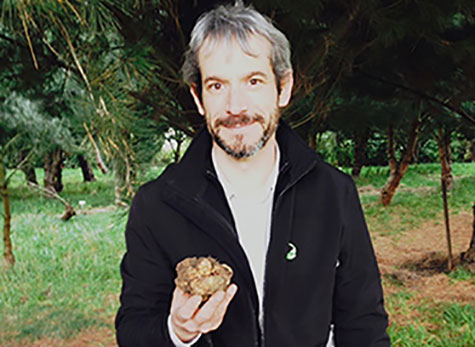Growing truffles and saffron milk cap mushrooms in pine forests could add a valuable second income stream for forest owners.
Plant and Food scientists investigating the cultivation and commercialisation saffron milk cap and Bianchetto truffle believe they offer exciting potential for the forestry industry.
Alexis Guerin of Plant and Food with what is believed to be New Zealand’s largest white truffle. Alexis Guerin and Associate Professor Wang Yun have been investigating the high-value delicacies on a farm in Lincoln with successful and tasty results. “These crops could be the next innovative gourmet export food product for New Zealand,” say Alexis. “Elsewhere in the world they are highly regarded for their potential health benefits and even support a dedicated truffle-tourism industry.” In New Zealand, truffles retail for around $3,000/Kg, but Alexis says that “you don’t need 1Kg to enjoy them, the flavour is powerful and sensational. A few grams per person is enough for some of the best recipes”. While Perigord black truffles have been grown commercially in Europe since the early 1800s, it was not until the 1970s that their cultivation methods were improved by scientists. Similarly the cultivation of most other edible mycorrhizal mushrooms is still very much in its infancy. The research by Alexis and Wang Yun into saffron milk cap mushrooms provides another commercial opportunity. “We harvested 85 kg of saffron milk cap in the 2014 season from January to May. The high yield was in part because of irrigation on some sites and very favorable conditions with warm temperatures and regular rainfall.” Both crops are the fruits of perennial fungi that live in symbiosis with trees. The fungi colonize roots and transform them into mycorrhizae (from Greek, ‘fungus-root’), real root organs resulting from the merger between plant and fungal tissues. The fungus supplies the tree with water and nutrients while the tree provides the fungus with soluble carbohydrates from photosynthesis. The pair’s research, published in the international journal Mycorrhiza, also showed a symbiotic relationship between host pines, onset of fruiting, and mushroom yields; potentially improving the value of pine plantations by providing a secondary income and competitive control of the invasive and poisonous Amanita muscaria (fly agaric) well known for its red cap and white spots. Yet while research to date has yielded promising results Alexis says that for both crops more research is required to further develop the young edible mycorrhizal mushroom industry in New Zealand, particularly understanding the factors that affect yields and the postharvest storage, packaging, and shelf-life of the gourmet delicacies.



0 Comments
Leave a Comment